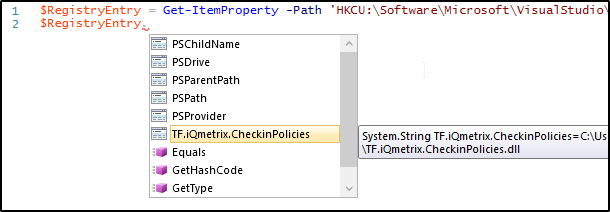Accessing PowerShell Properties and Variables with Periods (and other special characters) in their Name
TL;DR
If your PowerShell variable name contains special characters, wrap it in curly braces to get/set its value. If your PowerShell property name contains special characters, wrap it in double quotes:
# Variable name with special characters
$VariableName.That.Contains.Periods # This will NOT work.
${VariableName.That.Contains.Periods} # This will work.
$env:ProgramFiles(x86) # This will NOT work, because parentheses are special characters.
${env:ProgramFiles(x86)} # This will work.
# Property name with special characters
$SomeObject.APropertyName.That.ContainsPeriods # This will NOT work.
$SomeObject.{APropertyName.That.ContainsPeriods} # This will work.
$SomeObject.'APropertyName.That.ContainsPeriods' # This will also work.
$SomeObject."APropertyName.That.ContainsPeriods" # This will work too.
# Property name with special characters stored in a variable
$APropertyNameWithSpecialCharacters = 'APropertyName.That.ContainsPeriods'
$SomeObject.$APropertyNameWithSpecialCharacters # This will NOT work.
$SomeObject.{$APropertyNameWithSpecialCharacters} # This will NOT work.
$SomeObject.($APropertynameWithSpecialCharacters) # This will work.
$SomeObject."$APropertynameWithSpecialCharacters" # This will also work.
$SomeObject.'$APropertynameWithSpecialCharacters' # This will NOT work.
More Information
I was recently working on a powershell script to get the values of some entries in the registry. This is simple enough:
Get-ItemProperty -Path 'HKCU:\Software\Microsoft\VisualStudio\11.0_Config\TeamFoundation\SourceControl\Checkin Policies' -Name 'TF.iQmetrix.CheckinPolicies'
If we run this command, this is what we get back:
TF.iQmetrix.CheckinPolicies : C:\Users\Dan Schroeder\AppData\Local\Microsoft\VisualStudio\11.0\Extensions\mwlu1noz.4t5\TF.iQmetrix.CheckinPolicies.dll
PSPath : Microsoft.PowerShell.Core\Registry::HKEY_CURRENT_USER\Software\Microsoft\VisualStudio\11.0_Config\TeamFoundation\SourceControl\Checkin Policies
PSParentPath : Microsoft.PowerShell.Core\Registry::HKEY_CURRENT_USER\Software\Microsoft\VisualStudio\11.0_Config\TeamFoundation\SourceControl
PSChildName : Checkin Policies
PSDrive : HKCU
PSProvider : Microsoft.PowerShell.Core\Registry
So the actual value I’m after is stored in the “TF.iQmetrix.CheckinPolicies” property of the object returned by Get-ItemProperty; notice that this property name has periods in it. So let’s store this object in a variable to make it easier to access it’s properties, and do a quick Get-Member on it just to show some more details:
$RegistryEntry = Get-ItemProperty -Path 'HKCU:\Software\Microsoft\VisualStudio\11.0_Config\TeamFoundation\SourceControl\Checkin Policies' -Name 'TF.iQmetrix.CheckinPolicies'
$RegistryEntry | Get-Member
And this is what Get-Member shows us:
TypeName: System.Management.Automation.PSCustomObject
Name MemberType Definition
---- ---------- ----------
Equals Method bool Equals(System.Object obj)
GetHashCode Method int GetHashCode()
GetType Method type GetType()
ToString Method string ToString()
PSChildName NoteProperty System.String PSChildName=Checkin Policies
PSDrive NoteProperty System.Management.Automation.PSDriveInfo PSDrive=HKCU
PSParentPath NoteProperty System.String PSParentPath=Microsoft.PowerShell.Core\Registry::HKEY_CURRENT_USER\Software\Microsoft\VisualStudio\11.0_Config\TeamFoundation\SourceControl
PSPath NoteProperty System.String PSPath=Microsoft.PowerShell.Core\Registry::HKEY_CURRENT_USER\Software\Microsoft\VisualStudio\11.0_Config\TeamFoundation\SourceControl\Checkin Policies
PSProvider NoteProperty System.Management.Automation.ProviderInfo PSProvider=Microsoft.PowerShell.Core\Registry
TF.iQmetrix.CheckinPolicies NoteProperty System.String TF.iQmetrix.CheckinPolicies=C:\Users\Dan Schroeder\AppData\Local\Microsoft\VisualStudio\11.0\Extensions\mwlu1noz.4t5\TF.iQmetrix.CheckinPolicies.dll
So in PowerShell ISE I type $RegistryEntry. and intellisense pops up showing me that TF.iQmetrix.CheckinPolicies is indeed a property on this object that I can access.

So I try and display the value of that property to the console using:
$RegistryEntry = Get-ItemProperty -Path 'HKCU:\Software\Microsoft\VisualStudio\11.0_Config\TeamFoundation\SourceControl\Checkin Policies' -Name 'TF.iQmetrix.CheckinPolicies'
$RegistryEntry.TF.iQmetrix.CheckinPolicies
But nothing is displayed :-(
While PowerShell ISE does color-code the line $RegistryEntry.TF.iQmetrix.CheckinPolicies to have the object color different than the property color, if you just look at it in plain text, something clearly looks off about it. How does PowerShell know that the property name is “TF.iQmetrix.CheckinPolicies”, and not that “TF” is a property with an “iQmetrix” property on it, with a “CheckinPolicies” property on that. Well, it doesn’t.
I did some Googling and looked on StackOverflow, but couldn’t a solution to this problem. I found slightly related posts involving environmental variables with periods in their name, but that solution did not work in this case. So after some random trial-and-error I stumbled onto the solution. You have to wrap the property name in curly braces:
$RegistryEntry.TF.iQmetrix.CheckinPolicies # This is WRONG. Nothing will be returned.
$RegistryEntry.{TF.iQmetrix.CheckinPolicies} # This is RIGHT. The property's value will returned.
I later refactored my script to store the “TF.iQmetrix.CheckinPolicies” name in a variable and found that I couldn’t use the curly braces anymore. After more trial-and-error I discovered that using parentheses instead works:
$EntryName = 'TF.iQmetrix.CheckinPolicies'
$RegistryEntry.$EntryName # This is WRONG. Nothing will be returned.
$RegistryEntry.{$EntryName} # This is WRONG. Nothing will be returned.
$RegistryEntry.($EntryName) # This is RIGHT. The property's value will be returned.
$RegistryEntry."$EntryName" # This is RIGHT too. The property's value will be returned.
So there you have it. If for some reason you have a variable or property name that contains periods, wrap it in curly braces, or parenthesis if you are storing it in a variable.
Hopefully this makes it’s way to the top of the Google search results so you don’t waste as much time on it as I did.
Happy coding!

Comments
Bala
Thank you! This helped me greatly!!
Leave a Comment
Your email address will not be published. Required fields are marked *